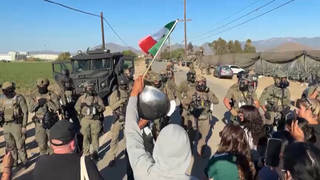
By Amy Goodman & Denis Moynihan
National Hispanic Heritage Month in the United States runs from September 15th to October 15th, starting mid-month when several nations celebrate their independence: on September 15th, Costa Rica, El Salvador, Guatemala, Honduras, and Nicaragua; on September 16th, Mexico, and Chile on September 18th. The month began as a week in 1968. This year, it coincides with the growing crisis along the U.S.-Mexico border. Thousands arrive daily seeking asylum but find instead razor wire, hostility and arrest. This flood of humanity is what Democracy Now! news hour co-host Juan Gonzalez calls “The Harvest of Empire,” the title of his seminal history of Latinos in America, as the consequences of colonial interventions abroad by the U.S. government create conditions in impacted countries that residents simply cannot endure.
On the day before this year’s Hispanic Heritage Month began, a federal judge in Austin, Texas ordered Texas to remove a thousand-foot floating barrier in the Rio Grande near Eagle Pass. The barrier, with large orange buoys strung together, separated by serrated saw blades, is the latest and perhaps most grotesque symbol of the anti-immigrant movement in the United States. Texas appealed the ruling, and a federal appeals court stayed the order as the case proceeds, allowing the barrier to remain in place. In early August, a body was found entangled in the barrier. Last week, the bodies of two drowning victims, an adult and a three-year-old child, were recovered nearby as well.
Most migrants face months of dangerous travel before even getting to the Rio Grande river crossing. “We want to cross into the United States for a better future. The journey has been very difficult. We have been mistreated. We have been hungry. We have suffered. The children are tired,” Makel Alexander, a Venezuelan migrant, told Reuters near the border. “We will cross the border so that we can do well, because our country is struggling.”
Makel’s story is repeated, day after day, as millions in the Western Hemisphere flee increasingly dangerous and desperate situations in their home countries.
“The historic interventions, the military interventions, the sanctions that we’ve imposed on different countries in Central America, in the Caribbean, in South America, and, of course, the failed war on drugs are all important factors that are displacing people, creating misery and responsible for much of the violence, corruption and impunity in Central America, increasingly in places like South America, like Venezuela,” Democratic Congressmember Jésus “Chuy” Garcia said on Democracy Now! “That is at the root of what is driving people to desperation. They’re coming to the U.S. seeking asylum and refuge, fleeing terrible consequences, risking their lives to get here.”
Garcia, the first Mexican-born U.S. Congressmember from the Midwest, has requested more federal assistance for Chicago as thousands of migrants arrive there – many bussed by Republicans like Texas Gov. Greg Abbott in cynical and potentially illegal political stunts.
The ongoing influx of migrants, as Rep. Chuy Garcia said, has deep roots in U.S. government interventions over many decades, including military interventions in the Dominican Republic, Haiti, Panama, Grenada, the U.S.-backed 1954 coup against the democratically-elected president of Guatemala and the ensuing U.S. support for murderous militaries and paramilitaries in Guatemala, El Salvador, Honduras and Nicaragua in the 1980s. Crushing economic sanctions imposed by the U.S. on Cuba and Venezuela echo the dictate issued by President Nixon to the CIA in 1970, launching the plan to overthrow Pres. Salvador Allende in Chile, to “make the economy scream.”
Latinos have played a central role in U.S. history, yet this rich history is under attack, as rightwing interests have derailed a Smithsonian Institution exhibit on their role in the civil rights movement, being developed for the planned National Museum of the American Latino.
“Our major concern was to just make sure that we were telling a truthful story, a complex story and a nuanced story about how Latinos have grappled with their relationship to the United States,” Felipe Hinojosa, a Baylor University history professor and one of the curators of the paused exhibit, explained on Democracy Now! “The larger and broader questions of who we are as a community and what is our relationship to the nation were central questions for Latino civil rights activists in the 1960s and 1970s.”
The civil rights exhibit has been replaced by one focusing on salsa music.
Instead of these complex narratives, we see a rising movement to erase history and supplant it with xenophobic soundbites. This dog-whistle racism, buttressed by razor-barbed buoys along the border, represents a dark and dangerous turn in our nation’s history. Let’s make Hispanic Heritage Month a time to celebrate diversity and to overcome the legacy of racism in the United States.












Media Options